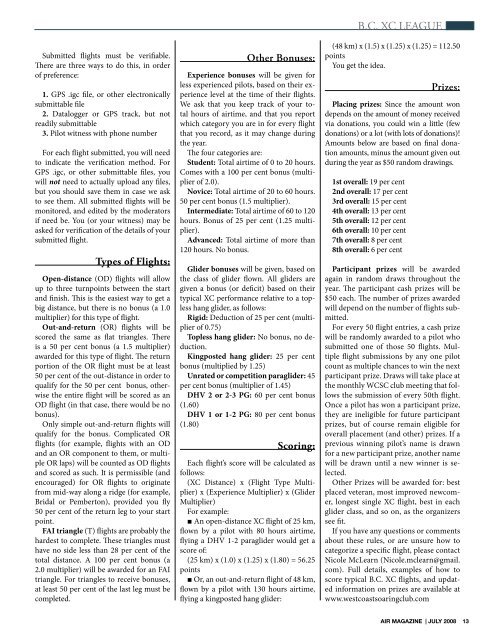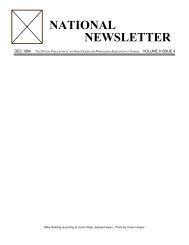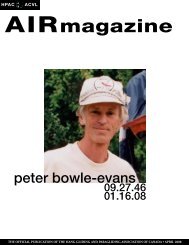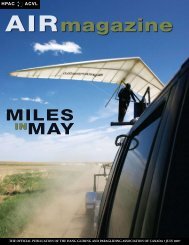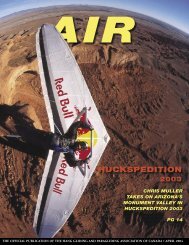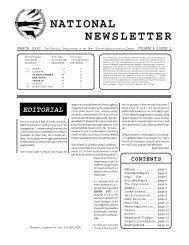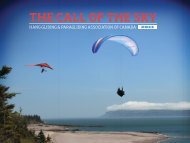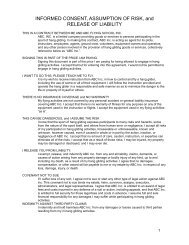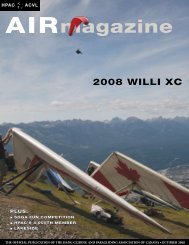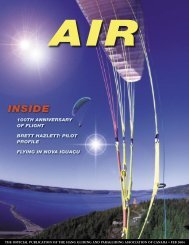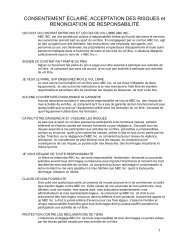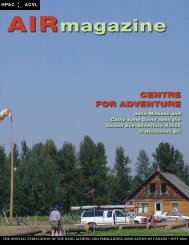2008-07 - Hang Gliding and Paragliding Association of Canada
2008-07 - Hang Gliding and Paragliding Association of Canada
2008-07 - Hang Gliding and Paragliding Association of Canada
Create successful ePaper yourself
Turn your PDF publications into a flip-book with our unique Google optimized e-Paper software.
Submitted flights must be verifiable.<br />
There are three ways to do this, in order<br />
<strong>of</strong> preference:<br />
1. GPS .igc file, or other electronically<br />
submittable file<br />
2. Datalogger or GPS track, but not<br />
readily submittable<br />
3. Pilot witness with phone number<br />
For each flight submitted, you will need<br />
to indicate the verification method. For<br />
GPS .igc, or other submittable files, you<br />
will not need to actually upload any files,<br />
but you should save them in case we ask<br />
to see them. All submitted flights will be<br />
monitored, <strong>and</strong> edited by the moderators<br />
if need be. You (or your witness) may be<br />
asked for verification <strong>of</strong> the details <strong>of</strong> your<br />
submitted flight.<br />
Types <strong>of</strong> Flights:<br />
Open-distance (OD) flights will allow<br />
up to three turnpoints between the start<br />
<strong>and</strong> finish. This is the easiest way to get a<br />
big distance, but there is no bonus (a 1.0<br />
multiplier) for this type <strong>of</strong> flight.<br />
Out-<strong>and</strong>-return (OR) flights will be<br />
scored the same as flat triangles. There<br />
is a 50 per cent bonus (a 1.5 multiplier)<br />
awarded for this type <strong>of</strong> flight. The return<br />
portion <strong>of</strong> the OR flight must be at least<br />
50 per cent <strong>of</strong> the out-distance in order to<br />
qualify for the 50 per cent bonus, otherwise<br />
the entire flight will be scored as an<br />
OD flight (in that case, there would be no<br />
bonus).<br />
Only simple out-<strong>and</strong>-return flights will<br />
qualify for the bonus. Complicated OR<br />
flights (for example, flights with an OD<br />
<strong>and</strong> an OR component to them, or multiple<br />
OR laps) will be counted as OD flights<br />
<strong>and</strong> scored as such. It is permissible (<strong>and</strong><br />
encouraged) for OR flights to originate<br />
from mid-way along a ridge (for example,<br />
Bridal or Pemberton), provided you fly<br />
50 per cent <strong>of</strong> the return leg to your start<br />
point.<br />
FAI triangle (T) flights are probably the<br />
hardest to complete. These triangles must<br />
have no side less than 28 per cent <strong>of</strong> the<br />
total distance. A 100 per cent bonus (a<br />
2.0 multiplier) will be awarded for an FAI<br />
triangle. For triangles to receive bonuses,<br />
at least 50 per cent <strong>of</strong> the last leg must be<br />
completed.<br />
Other Bonuses:<br />
Experience bonuses will be given for<br />
less experienced pilots, based on their experience<br />
level at the time <strong>of</strong> their flights.<br />
We ask that you keep track <strong>of</strong> your total<br />
hours <strong>of</strong> airtime, <strong>and</strong> that you report<br />
which category you are in for every flight<br />
that you record, as it may change during<br />
the year.<br />
The four categories are:<br />
Student: Total airtime <strong>of</strong> 0 to 20 hours.<br />
Comes with a 100 per cent bonus (multiplier<br />
<strong>of</strong> 2.0).<br />
Novice: Total airtime <strong>of</strong> 20 to 60 hours.<br />
50 per cent bonus (1.5 multiplier).<br />
Intermediate: Total airtime <strong>of</strong> 60 to 120<br />
hours. Bonus <strong>of</strong> 25 per cent (1.25 multiplier).<br />
Advanced: Total airtime <strong>of</strong> more than<br />
120 hours. No bonus.<br />
Glider bonuses will be given, based on<br />
the class <strong>of</strong> glider flown. All gliders are<br />
given a bonus (or deficit) based on their<br />
typical XC performance relative to a topless<br />
hang glider, as follows:<br />
Rigid: Deduction <strong>of</strong> 25 per cent (multiplier<br />
<strong>of</strong> 0.75)<br />
Topless hang glider: No bonus, no deduction.<br />
Kingposted hang glider: 25 per cent<br />
bonus (multiplied by 1.25)<br />
Unrated or competition paraglider: 45<br />
per cent bonus (multiplier <strong>of</strong> 1.45)<br />
DHV 2 or 2-3 PG: 60 per cent bonus<br />
(1.60)<br />
DHV 1 or 1-2 PG: 80 per cent bonus<br />
(1.80)<br />
Scoring:<br />
Each flight’s score will be calculated as<br />
follows:<br />
(XC Distance) x (Flight Type Multiplier)<br />
x (Experience Multiplier) x (Glider<br />
Multiplier)<br />
For example:<br />
■ An open-distance XC flight <strong>of</strong> 25 km,<br />
flown by a pilot with 80 hours airtime,<br />
flying a DHV 1-2 paraglider would get a<br />
score <strong>of</strong>:<br />
(25 km) x (1.0) x (1.25) x (1.80) = 56.25<br />
points<br />
■ Or, an out-<strong>and</strong>-return flight <strong>of</strong> 48 km,<br />
flown by a pilot with 130 hours airtime,<br />
flying a kingposted hang glider:<br />
B.C. XC LEAGUE<br />
(48 km) x (1.5) x (1.25) x (1.25) = 112.50<br />
points<br />
You get the idea.<br />
Prizes:<br />
Placing prizes: Since the amount won<br />
depends on the amount <strong>of</strong> money received<br />
via donations, you could win a little (few<br />
donations) or a lot (with lots <strong>of</strong> donations)!<br />
Amounts below are based on final donation<br />
amounts, minus the amount given out<br />
during the year as $50 r<strong>and</strong>om drawings.<br />
1st overall: 19 per cent<br />
2nd overall: 17 per cent<br />
3rd overall: 15 per cent<br />
4th overall: 13 per cent<br />
5th overall: 12 per cent<br />
6th overall: 10 per cent<br />
7th overall: 8 per cent<br />
8th overall: 6 per cent<br />
Participant prizes will be awarded<br />
again in r<strong>and</strong>om draws throughout the<br />
year. The participant cash prizes will be<br />
$50 each. The number <strong>of</strong> prizes awarded<br />
will depend on the number <strong>of</strong> flights submitted.<br />
For every 50 flight entries, a cash prize<br />
will be r<strong>and</strong>omly awarded to a pilot who<br />
submitted one <strong>of</strong> those 50 flights. Multiple<br />
flight submissions by any one pilot<br />
count as multiple chances to win the next<br />
participant prize. Draws will take place at<br />
the monthly WCSC club meeting that follows<br />
the submission <strong>of</strong> every 50th flight.<br />
Once a pilot has won a participant prize,<br />
they are ineligible for future participant<br />
prizes, but <strong>of</strong> course remain eligible for<br />
overall placement (<strong>and</strong> other) prizes. If a<br />
previous winning pilot’s name is drawn<br />
for a new participant prize, another name<br />
will be drawn until a new winner is selected.<br />
Other Prizes will be awarded for: best<br />
placed veteran, most improved newcomer,<br />
longest single XC flight, best in each<br />
glider class, <strong>and</strong> so on, as the organizers<br />
see fit.<br />
If you have any questions or comments<br />
about these rules, or are unsure how to<br />
categorize a specific flight, please contact<br />
Nicole McLearn (Nicole.mclearn@gmail.<br />
com). Full details, examples <strong>of</strong> how to<br />
score typical B.C. XC flights, <strong>and</strong> updated<br />
information on prizes are available at<br />
www.westcoastsoaringclub.com<br />
AIR MAGAZINE | JULY <strong>2008</strong> 13


